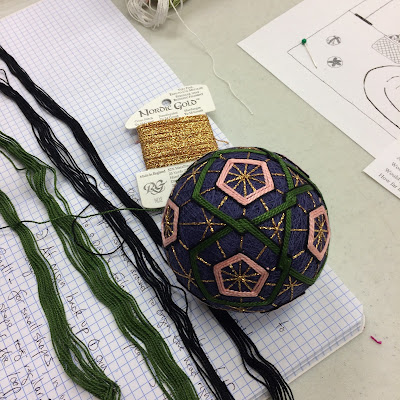Yatsuhashi (Eight Bridges) is one of the designs required for Level 3 (Shihan) certification in the Japan Temari Association curriculum. It's a combination 8 division ball that is covered with stitched threads, an all-over design. There are two different continuous paths that are stitched in a layered fashion. You use doubled thread and have the challenge of needing to work some stitches with your needle turned at angle that is a bit different from normal. All these techniques combine to make this a very challenging design!
This design is from the Japanese book Temari from Different Parts of Japan (Zoku Kyodo no Temari) by Chiyoko Ozaki, ISBN 4-8377-0990-7.
I tried it first with #5 pearl cotton thread and was not happy with the result. While not bad, I didn't like the way the threads piled up so high between keeper pins - unruly thread, rolling this way and that! These are the traditional colors with purple representing irises and the red-yellow progression representing the bridges. The story behind this design is truly fascinating! That's one of the things I love about studying temari - I also learn a bit about Japanese culture and history.
This past weekend I headed to my local needlework shop and found this lovely palette of Vineyard silk. Perfect! Now, I feel that I have truly mastered this design.
 |
| Yatsuhashi by Barbara B. Suess |
☆*:.。.o(≧▽≦)o.。.:*☆*:.。.o(≧▽≦)o.。.:*☆*:.。.o(≧▽≦)o.。.:*☆
Level 1 - Beginner
Level 2 - Advanced
Level 3- Instructor
Level 4 - Master






























